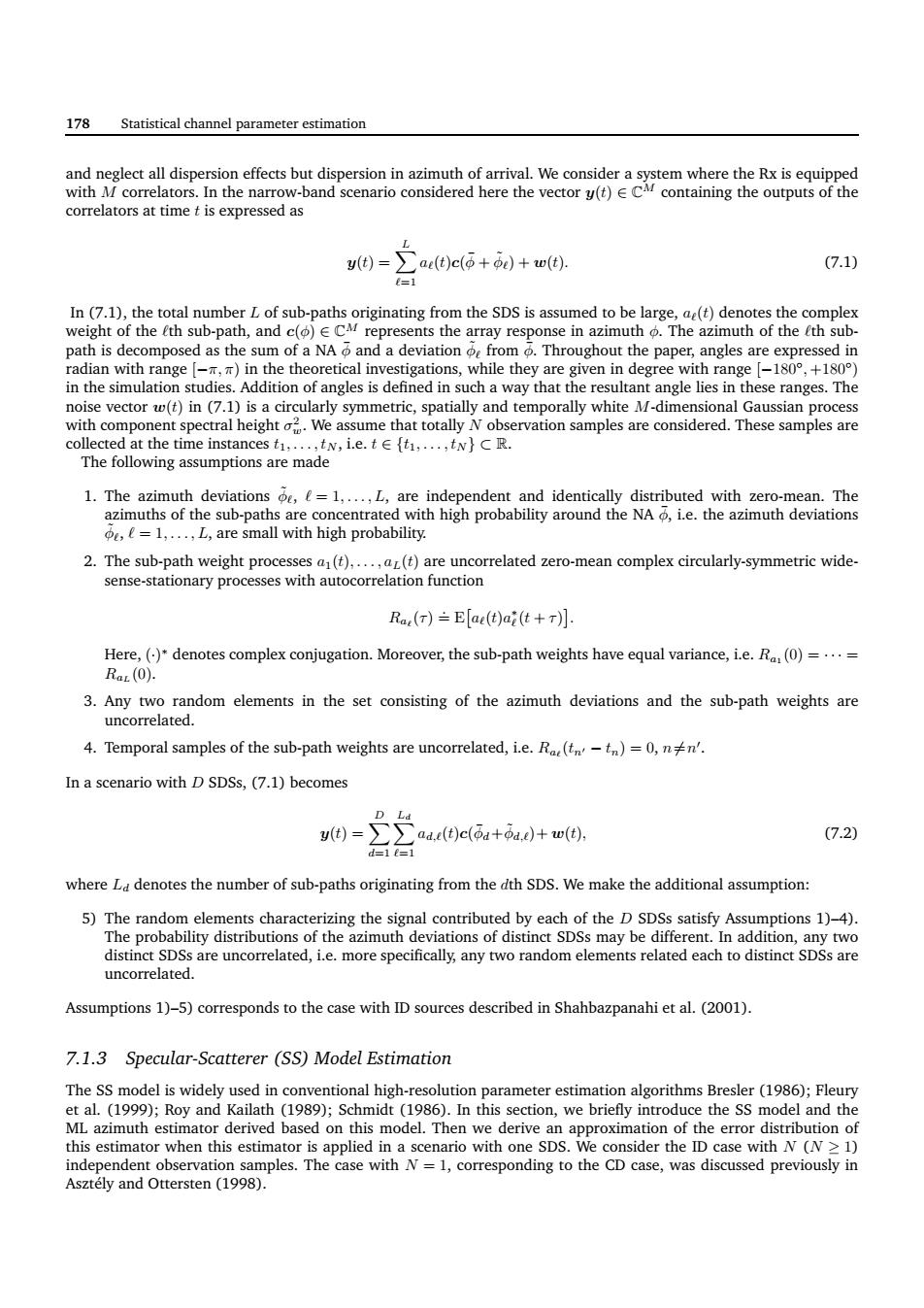正在加载图片...

178 Statistical channel parameter estimation ects bu correlators at time t is expressed as (7.1) in the simulation studies.Addition of angles is defined in such a way that the resultant angle lies in these ranges.The e vector N,ie.tE ft.....N)CR wing assumptions are made 1.The azimut ,t=bei are small with high probability. are unc orrelated zero-mean complexciruarly-symmetric wide R,(r)E[ae()it+ Here )denotes complex conjugation.Moreover,the sub-path weights have cqual variance,L.e.) 3.Any two random elements in the set consisting of the azimuth deviations and the sub-path weights are uncorrelated. 4.Temporal samples of the sub-path weights are uncorrelated,i.e.R)=0, In a scenario with D SDSs,(7.1)becomes Caat(t)c(3a+3a.t)+w(t). 7.2) where L denotes the number of sub-paths originating from the th SDS.We make the additional assumption: d by eac of the DSDs ss satisfy Assu umptions 1)-4) distinct SDSs are uncorrelated.i.e.more specifically any two random elements related each to uncorrelated. Assumptions 1)-5)corresponds to the case with ID sources described in Shahbazpanahi et al.(2001). 7.1.3 Specular-Scatterer(SS)Model Estimation The ss model is widely used in conventional high-resolution parameter estimation algorithms bresler (1986):Fleur uand kanlath (189):smidr (s sccion,we brietly introduce the nd th 0n we derive s approxima on of the error 0 The orepoding to the CD case,a dicued previouly in178 Statistical channel parameter estimation and neglect all dispersion effects but dispersion in azimuth of arrival. We consider a system where the Rx is equipped with M correlators. In the narrow-band scenario considered here the vector y(t) ∈ CM containing the outputs of the correlators at time t is expressed as y(t) = X L ℓ=1 aℓ(t)c(φ¯ + φ˜ ℓ) + w(t). (7.1) In (7.1), the total number L of sub-paths originating from the SDS is assumed to be large, aℓ(t) denotes the complex weight of the ℓth sub-path, and c(φ) ∈ CM represents the array response in azimuth φ. The azimuth of the ℓth subpath is decomposed as the sum of a NA φ¯ and a deviation φ˜ ℓ from φ¯. Throughout the paper, angles are expressed in radian with range [−π, π) in the theoretical investigations, while they are given in degree with range [−180◦ , +180◦ ) in the simulation studies. Addition of angles is defined in such a way that the resultant angle lies in these ranges. The noise vector w(t) in (7.1) is a circularly symmetric, spatially and temporally white M-dimensional Gaussian process with component spectral height σ 2 w. We assume that totally N observation samples are considered. These samples are collected at the time instances t1, . . . , tN , i.e. t ∈ {t1, . . . , tN } ⊂ R. The following assumptions are made 1. The azimuth deviations φ˜ ℓ, ℓ = 1, . . . , L, are independent and identically distributed with zero-mean. The azimuths of the sub-paths are concentrated with high probability around the NA φ¯, i.e. the azimuth deviations φ˜ ℓ, ℓ = 1, . . . , L, are small with high probability. 2. The sub-path weight processes a1(t), . . . , aL(t) are uncorrelated zero-mean complex circularly-symmetric widesense-stationary processes with autocorrelation function Raℓ (τ) .= E aℓ(t)a ∗ ℓ (t + τ) . Here, (·) ∗ denotes complex conjugation. Moreover, the sub-path weights have equal variance, i.e. Ra1 (0) = · · · = RaL (0). 3. Any two random elements in the set consisting of the azimuth deviations and the sub-path weights are uncorrelated. 4. Temporal samples of the sub-path weights are uncorrelated, i.e. Raℓ (tn′ − tn) = 0, n6=n ′ . In a scenario with D SDSs, (7.1) becomes y(t) = X D d=1 X Ld ℓ=1 ad,ℓ(t)c(φ¯ d+φ˜ d,ℓ)+ w(t), (7.2) where Ld denotes the number of sub-paths originating from the dth SDS. We make the additional assumption: 5) The random elements characterizing the signal contributed by each of the D SDSs satisfy Assumptions 1)–4). The probability distributions of the azimuth deviations of distinct SDSs may be different. In addition, any two distinct SDSs are uncorrelated, i.e. more specifically, any two random elements related each to distinct SDSs are uncorrelated. Assumptions 1)–5) corresponds to the case with ID sources described in Shahbazpanahi et al. (2001). 7.1.3 Specular-Scatterer (SS) Model Estimation The SS model is widely used in conventional high-resolution parameter estimation algorithms Bresler (1986); Fleury et al. (1999); Roy and Kailath (1989); Schmidt (1986). In this section, we briefly introduce the SS model and the ML azimuth estimator derived based on this model. Then we derive an approximation of the error distribution of this estimator when this estimator is applied in a scenario with one SDS. We consider the ID case with N (N ≥ 1) independent observation samples. The case with N = 1, corresponding to the CD case, was discussed previously in Asztély and Ottersten (1998).��